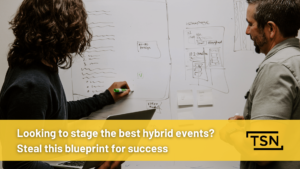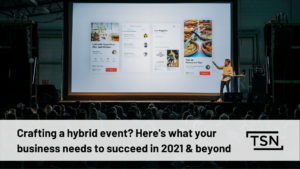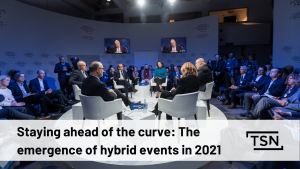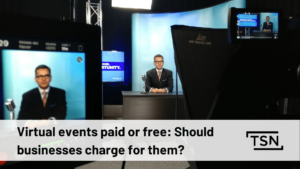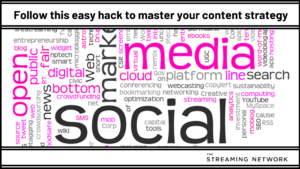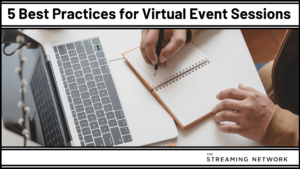Podcast: Play in new window | Download | Embed
Subscribe: Apple Podcasts | Google Podcasts | RSS
Lessons From The Frontline
In our last episode, we discussed some of the challenges faced by marketers producing hybrid events. As a refresher, hybrid events are when you merge your physical event (like a conference) with a live webinar.
My co-host, Peter Vamos, and I delved into the common mistakes B2B marketers make and how to avoid them.
This week, Peter and I wanted to discuss a content marketing strategy all marketers should be implementing. Especially with their webinar program.
Repurposing content
Content can come in many forms:
- Blogs.
- Podcasts.
- Webinars.
- Lead Magnets.
- Email Campaigns.
- And much more.
But these pieces don’t have to have a short shelf-life. If you need inspiration for new content, look back at what you have already produced. What worked? What didn’t?
Don’t know where to start? Watch our twelfth episode where we discuss the following:
- What is repurposing content? What does it mean and how is it advantageous to your business?
- Our own experience with repurposing content: How we did it, what the results were, and why it was successful. Here is an example of how we repurposed our content.
- Tips on where to find your cornerstone content for repurposing: Talk to your Thought Leaders, your team on the front lines (sales representatives), your board, etc.
The Complete Video Transcript
Peter Vamos: Welcome to another episode LFTF.
Matthew Ley: He’s got a short form now. Acronym.
Peter Vamos: Short form. Lessons from the Frontline. The webinar podcast series that disseminates all things webinar with Matthew Ley, President of The Streaming Network. Matthew, thank you again for joining me here. We are clearly not in my basement.
Unidentified Man: No, no, we’re not. But we do appreciate the cozy atmosphere that’s been created by this burning fireplace we have on the TV.
Peter Vamos: We are getting ready for Thanksgiving and it’s all ready. Even though this isn’t real the psychology of this thing is making me sweat. So, it’s that real.
Matthew Ley: The truth is I was shooting a webinar down here this morning for Advocamp which is Influitive’s upcoming conference or by the time you guys get this it might be already passed. I’m not sure, it probably will. And we had the set all set up so I figured it would be a good day to get you back in and get a few of these podcasts hammered out.
Peter Vamos: So here we are. Completely different desk, completely different atmosphere. This is the studio. We never actually were in my parent’s basement.
So today we are going to dig into a subject that’s near and dear to my heart as a content creator, the constant struggle. You create a piece of content, that piece of content goes out there and then it sometimes works, sometimes doesn’t work. And if it works that’s great but even then, there’s things you can still be doing with it. And if it doesn’t work certainly you should be trying to come up with things you can do with it. So, we are going to talk about the repurposing of content.
So, let’s talk about, let’s just dive into sort of what the advantages are of repurposing content. When we save repurposed content like what do you mean?
Matthew Ley: Well, I mean it’s basically using content over and over again. In some cases, it’s taking content and delivering it in different ways. I mean most B2B marketers are pretty committed to content, addicted to content.
They know the more good content they put out there generally speaking there KPIs go up, more better leads, more engaged prospects and the like and so they have a pressure that they put on themselves. And there’s a pressure on them to be putting up content almost daily.
A staff from last year said that 67% of marketers are producing content daily whether that be something like a podcast like this or you know, some social posts or whatever it might be. So, there’s a lot of pressure there and I think the only way of doing it and doing it well is to repurpose.
Peter Vamos: Right. Right. No, and I agree 100%. I think to keep one piece of content and never do anything else with it is a waste of money and a waste of great opportunity.
So, when we are talking about repurposing in fact, this podcast is going to be repurposed so let’s talk a little bit. What do we do with this podcast? We shoot a podcast, we’ve shot a bunch of these things and then we–.
Matthew Ley: We do all kinds of stuff. I mean you say it’s near and dear to your heart, it’s the only way that we have a content strategy is repurposing, right? So, we’ve got this studio that’s below our office and so I am able to come down here with you and we are able to strategize in a meeting, come in and do a podcast like this.
So, it’s 20 minutes or it should be and then we break it up and we put it on to our YouTube site for short format video, it’s now fueling the hub on our website and certain content experiences that we are creating for different sectors. Like a couple of podcasts ago we were talking about financial services and we did two parts because we had so much to say, it’s become such a big part of our business.
Well, those clips are in our content experience. Those videos became part of a webinar series and of course, we are delivering it as a podcast and a blog. So, we do one of these and we get anywhere from 20 to 30 pieces of content out of it. Folks, not me, take it and turn it into other assets for us digital or written or interactive or whatever it might be and then we come back here and we do it all again.
So, it’s a necessity for a business our size where I’m running the business but I’m also the thought leader. If I’m going to produce content at any regular interval I’ve got to be repurposing and this is the way that we are doing it ourselves.
Peter Vamos: And we don’t even go as far as you can go with these things. We do a certain number of things. Last year you guys put together this was before my time here, you put together an ROI webinar that kind of around here is the gold standard for this philosophy. Tell us a little bit about it. Like we’ll dig into it but just give us what was the ROI webinar?
Matthew Ley: Well, first off before you were here it was like the only thing we did that year I think. Anything else we did we were asked to do by somebody else like I was at a conference or whatever. But yeah, so I mean I like the ROI webinar as an example because of its origins, make sense to people and then just how far it went.
So, the ROI webinar was based around the year before we had done a lot of data-driven stuff. So, we had dug into the webinar benchmarks, Demand Metric was doing a series on just the data-driven approach to marketing which was big and everyone was talking about it. And so, we did a lot on the various datasets that people just didn’t know about.
And with that, we started getting into some sort of recommendations around it but we haven’t really put it together. So, as we went into the new year we had been down at Webinar World and worked with our partner , we’d been talking to our customers, we got some really great customer stories about how they were getting ROI and they were basing it around that data they had gotten the year before and some great best practices came out of it and whatnot.
So, what we did because it was about we were about midway through our transformation from a gig-based business that sold you a webinar or a series or whatever to a buy a subscription from us and we were getting into some renewals. So, we decided that we would wrap up this ROI presentation and relate it to our key customers as we were going into the renewal meetings.
So, we benchmark them against the index. We brought forward the stories and the aspects of how companies like Hotspot or Microsoft or whomever were getting ROI and we built it into this presentation.
Peter Vamos: And when you brought this did you understand that this was going to be a big project? Was this sort of the project that was going to be the cornerstone for the year or was it really just an attempt to bring all of the stuff together?
Matthew Ley: I think we got the message that as we were going into our first real run of renewals that if someone’s going to renew on a software and our software is a fairly expensive one I mean it’s not $50 a month or whatever. If you are going to renew on a software you want to be seeing an ROI. And at the time we found that our customers were sometimes struggling to show that ROI. The webinar was one aspect and it still is just one aspect of why a customer buys from you but they weren’t drawing those straight lines between the webinar and the revenue.
That was downstream. That was sales or something else that was kind of doing it. And so, we knew that it was important. We strategized with about it and we recognized so we knew we were going to be talking about ROI but no, there was no grand plan with this presentation. I had no idea that it was going to become the anchor of content for the year.
Peter Vamos: Okay. So, what we’re going to do is we are going to reverse engineer this. So, you didn’t know at the time. What we’ve discovered from that is you can know and you can do things and probably even do and this was an excellent example of this thing but if you actually know going in on like how this is going to be treated, there’s probably a whole lot of other things you can do with it and there’s all sorts of things.
Matthew Ley: Right, but I would say that before you even get into the reverse engineering of it there’s probably people who will have the same experience where they do something for a purpose and then I was asked to deliver it at a conference. Someone liked it so much. This is a great presentation I run this, I volunteer on the Board of the Association, Marketing Association, would you be able to do this for the group? We are doing like a one-day conference.
So great, I went out and I did it for the group, changed it up slightly so it was not customer specific and after I delivered it a couple of times as an actual presentation it made perfect sense to deliver it as a webinar. So, I know that most companies who have got their thought leaders out there and they’ve got their presentation, they’ve got their thing that they do and so that thing is probably a pretty good piece of evergreen content.
The stuff that’s in this ROI presentation I mean if you go back and watch it it’s two years old now but I know that I’ve said almost every antidote from it I’ve repeated every week since. The content is still relevant to people.
Peter Vamos: So, it started out as a presentation you were making to human beings, evolved into a webinar, natural sort of next step.
Matthew Ley: That’s right, yeah.
Peter Vamos: All right, so let’s go through it. So now you do this thing, you do the webinar and take us through all of the different pieces and how it came together.
Matthew Ley: So right away we were repurposing kind of not on purpose if you will as this was– we decided we’re going to do a webinar and we were in between. We were doing a series demand metric, we weren’t sure where that was going to go. We couldn’t get John in studio and so we decided we were just going to do this anyway and he’s like great, I got a spot we’ll distribute it on ours.
All right but we had planned to do it ourselves so what we did was we shot the webinar and we did three different intros for The Streaming Network, Demand Metric and for a partner at the time, a company we later acquired called Momentum Conferencing. They were looking– we were looking to do something for them and we basically just did three intros not even three extros(SP) I don’t think we have three intros that we could deliver three different times in webinar format and distribute it to different audiences with a slight different change which was basically this Demand Metric webinar, this Streaming Network webinar.
So, we started with that and then we had for some time since the first season of what we called better webinars, our webinar series ourselves is we would take in video clips and we had been posting them on our YouTube page and had been using them. A lot of sales enablement, a little bit on the website but nothing really strategic, we didn’t really have a strategic content direction at the time.
So, we had the videos there and it was at that time that a marketer from had come to me and said hey, I just watched this thing that you did. I’ve wrote a two-piece blog article. Do you mind if I just send it to you? We want to post it in the next couple of weeks. Can you review it?
So, it was written in my name and I had never spoken to this person before. It was completely from the ROI presentation and so I was like, that’s cool. That’s easy. And we started doing that.
So, we posted, I think we created three part one, part two, part three ROI blogs that someone on our marketing team had worked with me on and we posted them sequentially over a week and once that was done we realized that we had enough content I guess to put it together something sort of a larger piece. So, we created an e-book that you can access in our hub. It’s Smart Marketer’s Guide to Webinar ROI which basically just takes these video clips and a bunch of the word content, a little bit of research and then wraps it up and we spit that out.
Peter Vamos: And that was taking all of this content. It amounts to a white paper, right?
Matthew Ley: It’s a white paper, an e-book. It was more of a how-to. How to get ROI out of your webinar program and the blogs extrapolated on the ideas from these short videos or the videos and then the e-book extrapolates just a little bit more from there.
Peter Vamos: But you used the blog content as your sort of foundational like the text and that thing.
Matthew Ley: That was it, yeah.
Peter Vamos: Put the videos in.
Matthew Ley: Put the videos in, some images. It’s funny, it’s images from the slide deck that I built personally at the time and then it’s a couple of clips from the videos that we did, words from the blog and then just somebody just massaging it so it feels like chapter 1, chapter 2, chapter 3.
And that was a good piece of rock, that was a good piece of content for getting downloads and that sort of thing. And then from there, we were working on an interactive piece which was something called the webinar report card. So, another great Canadian company in our space, (unintelligible) had just done a maturity assessment on video. The company that did that came to me and said hey, you should probably do something on do something with you on webinar that’s a great maturity assessment, sounds very complicated. I don’t know how to test someone’s maturity but I can give you what I’ve got.
And I basically gave them all of the stuff. I said this is I think what you want from me. Here’s these videos, here’s a webinar, watch it, here’s an e-book. Usually when I go when I talk to people, the first thing I ask them is what are your number so I can help them give them some ideas and they said this is perfect.
So, we created a report card which is basically asking people where their numbers are in their program and it’s around conversions and engagements and a bunch of other things. And then what we do is based on where they are at against the actual benchmark at the time from the webinar benchmarks report and the Canadian version that we do, we spit back out to them some ideas.
And those ideas are video clips from this ROI webinar and a series of points from the e-book or whatever it might be. So basically and that actually got launched at the beginning of the following year because it took a bit of coding and programming on all of that to get it done, so I mean it was a full year and if you go to our website now on the main page because we always rotate to the top-performing content the report card and the e-book are still there even though we’ve gotten a lot better thanks to you primarily at producing more content but they are still some of our top-performing pieces.
Peter Vamos: That’s great. So, and those that are watching hopefully as we are talking you are seeing things flashing on the screen obviously this is a podcast so we’re not flashing things and speaking to them but will by the magic of post-production we will have some footage and some clips and some stills of exactly what you’re talking about. Otherwise, if somebody wants to go look at this where would they go if they wanted just to just look at the whole–?
Matthew Ley: You know what, I think now hearing this and seeing this and just looking at the word ROI I would just visit the website because you will see it sprinkled. I mean the interesting thing, too, is you had asked me about this and I said this is the best example I got and then I went back through and I searched ROI on the website and now that we have I have some blogs ghostwritten for me now from people at our agency who based around what our calendar is and what we are doing, I went and looked and saw well, there’s a bunch more of this stuff. Like these ones are more deep. We’ve gone from the high level and we’ve drilled down but there’s more ROI stuff constantly being produced based around the words that I said almost 2 years ago.
Peter Vamos: So not only does it feed current content but it actually starts to feed ideas into more content down the road?
Matthew Ley: I mean yeah, I mean what gives ROI to a webinar program in one industry or another especially now that we’ve gone vertical and we’ve started getting into a little bit of personalization by the industry, is that the ROI story differs slightly from vertical to vertical or organization to organization. But it’s very similar, right?
And so, what’s been happening is as we’ve been going down this verticalization or as we’ve been going down talking about on demand because on demand has grown so exponentially in the past year or so we are going back to a lot of these still true points and my words are continuously being hashed out on paper and whatever they might be.
I never answered it but in hindsight, if ROI is what I’m talking about this year this would have been a great strategy. It was lucky but it would’ve have been a great strategy is go deep into an idea, get out in front of customers and make sure it’s resonating really, really well. So, test it. Once you know you’ve got it get out and produce a really strong piece of rock content which turned out to be this webinar, that will help fuel what you were talking about for the rest of that year or the quarter depending on how evolved your content strategy is.
Peter Vamos: And you could really be, you could be pulling data in, you could be looking at what people are searching for. You could really put together a real strategy based on where customers are potentially engaging with you and then just start to pick like what are all the different pieces that we need to this thing. Go in, that’s what I mean by reverse engine, like you guys did it in a certain way but if you go at it the other way and go we need 15 pieces of contents these are all of the things and know that you are going to cover all of those things in order to get a full year’s worth of content out of it and we are going to do this one big thing; sit down once and then the rest of it is just people around you chipping the rock. Chipping the pieces off the rock.
Matthew Ley: But I would suggest you take that other step, too, to that point is that we’ve all been there and I know I have sat in a room with a bunch of people that all know a lot about what we do. Right? We sit there and talk about yeah, I think people will really like this kind of thing and then when it gets out there it doesn’t resonate with anyone because it’s too inside baseball or whatever it might be.
I think testing the message is important and a webinar is a great place to test the message. Maybe not a webinar like this where we are focusing on creating something to go long-term, highly produced, multiple cameras, all of that stuff but just a standard webinar or what I did, the human one-on-one presentations worked. But getting that, getting that back.
The other thing that you can do too, this was done because this was our go-to message but the other thing that works really well for the content is what we refer to as evergreen content. Right? So, your customer success management team CS, CSMs or CS or CX whatever you call them, the people on the front line you know they are getting the same questions all of the time. Let’s be honest. There isn’t a webinar a topic or a presentation I give that I don’t talk about engagement, ROI or how to get more people out to watch.
It’s going to come up every time whether you ask it or I bring it into the conversation. That’s going to be talked about all of the time. So, I’m sure everyone’s business is listening to this that there’s questions and there’s things that you take people through all of the time, it’s your special sauce. It’s the thing that you guys do differently or it’s there’s aspects of about the market that people don’t understand and that you need to explain to them.
That is this kind of stuff. Right? You do it like we did which turned out again, by accident to be done really well and in really nice snackable pieces with a really polished delivery that made sense to people and you might never have to do it again for two or three years. Save time, feel your overall marketing content by plan. There’s a lot to come out of it.
So, you can go at it from the strategy that you said. You can go at it from what from your people side of it what are the things you’re being asked. You can go at it from your thought leaders, your executives, what are they giving when they get on stage and use that. But either way, this sort of process works well.
I know I’m talking a lot more than I normally do on an answer but I don’t want–.
Peter Vamos: Actually, not a lot more than you normally do.
Matthew Ley: No.
Peter Vamos: No, it’s pretty much on par.
Matthew Ley: Well, what I will finish is–.
Peter Vamos: Because you’re very passionate.
Matthew Ley: Yeah, we talk about this like it’s all real easy but a lot of human work went into all of this. Like you don’t want to think about doing what we did. We did this because we had to. It was working and we weren’t producing a lot of other content.
But there’s a lot of work that goes into editing all of that video. The writing of the blogs for people not usually taking my words and turning them. The designing of the e-book. The engineering of all of these things. So, it takes a lot of work to do all of this but when you’ve got something that works if it ain’t broke don’t fix it.
Peter Vamos: And you’ve touched on this a little bit but in terms of like why do you think this piece worked so well? Like was it the topic, was it the format, like what is it that made this thing go?
Matthew Ley: Well, I think we aspired to answer a question in that that people have been asking for a while and were struggling to answer. I think that’s just it is that someone, not me recognized that our primary buyer– the webinar producer within an organization is generally a cog within the wheel. A lot of companies recognize that the webinar is an important part of the marketing strategy. They know that they anecdotally knew that people that went through webinars were more likely to buy.
They had some integration especially our customers were really well integrated but that idea of that spend to that dollar, sorry that spend to that pipeline or that growth that wasn’t really there and they wanted to validate the return on investment so that they could help get more budget to do more, right? Because they knew that they were driving more overall pipeline. They just couldn’t draw the line. So, I think it was the right message at the right time for people.
Peter Vamos: But it’s also the thing people are looking for. People are searching for that so you are going to get more traffic. People are going to find that stuff because it’s just going to be your SCO is going to be much better if you are putting something out there that somebody actually cares about.
Matthew Ley: And I think this happens with a lot of companies. I joke around, I was joking around with the gentleman from Influitive about how I end up always doing one, two or three presentations and it’s been going on not for a short time but for a long time. So, it’s the engagement ones, these ones and a lot of about video. He’s like that stuff that people still don’t understand. And I’m like yeah.
If you can distill it and it makes sense then it’s stuff that’s always going to kind of work. I think these are like indicators, indicators of content that is going to be good and when you find something like that story that really resonates with everyone, that case, that antidote, that whatever you got to run with it.
Peter Vamos: Listen, so we are out of time. We’re trying to keep these to 20 minutes so sometimes what we are doing is one and two so there will be a part two to this conversation. We are going to continue the conversation.
So, Matthew, thank you very much for this first part of the conversation. Until the next one, we are going to continue to talk about how to repurpose and disseminate content. So, until next time I’m Peter, Matthew Ley.
Matthew Ley: Thank you.
Peter Vamos: Until next time.

